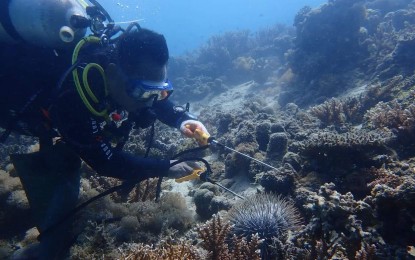
PROTECTING CORALS. A volunteer collects a crown of thorns starfish in the seawaters of Liloan, Southern Leyte in this undated photo. The daunting task and limited resources have not discouraged their group called “Dap-ag Boys" from manually picking thousands of the destructive and venomous starfish. (Photo courtesy of Dap-ag Boys)
LILOAN, Southern Leyte – The daunting task and limited resources have not discouraged a group of volunteers in this coastal town from manually picking thousands of destructive and venomous crown of thorns starfish (COTS) that have been damaging coral reefs.
The 12 regular members of the group known, as “Dap-ag Boys," spend their weekends collecting COTS, a large marine invertebrate, locally called "dap-ag".
Ryan Tomol, one of the founders of the “Dap-ag Boys,” said in an interview over the weekend that since 2019, their group, composed of fishermen and government workers, has picked more than 6,000 COTS within a 100-meter underwater area from the shoreline.
“Our concern for the livelihood of fishermen has been driving us to collect this starfish. Without healthy reefs, fish will be gone,” said Tomol, who works as an administrative staff at the Southern Leyte State University.
He said they remove COTS from corals and bury them underground.
They collect 200 to 300 COTS per dive, usually on weekends. Each dive lasts 60 minutes to 75 minutes.
“Collecting and burying COTS is the most effective method of eradicating the coral predator. We tried to inject the starfish with bile salt or vinegar, but buoyancy underwater affects the process,” Tomol added.
Chopping the starfish in half or into smaller pieces is discouraged since they can regenerate arms and, in extreme cases, may be able to regenerate from only half of an animal.
Tomol noted that every refill of an air tank costs PHP2,500 and their divers are unpaid. They have been getting support to finance their collection efforts from the non-government environmental group Oceana and the municipal government.
Oceana Campaign and Legal and Policy senior director Rose Liza Eisma Osorio lauded the volunteers for their concern for protecting corals.
“This is just a local initiative, and more have been involved. What started as a community initiative is now supported by local government and other agencies,” Osorio said.
Mayor Jonna Adan said COTS outbreaks have been noted this year in five coastal villages of Liloan town, affecting the livelihood of fishermen.
“The situation prompted us to conduct a COTS collection drive for 11 days last May, and we've been able to gather 3,000 starfish,” Adan told the Philippine News Agency.
Osorio calls for stronger protection of corals in the seawaters of Liloan town since it is part of Panaon Island, tagged as one of the 50 priority reefs in the world. Its coral reefs will highly likely survive the devastating impacts of climate change.
The overall mean hard coral cover of Panaon Island, according to Oceana, was estimated at 39.71 percent, higher than the 22.8 percent at the national level.
Panaon is from the word "pana,” or spear, a traditional and sustainable way of catching fish. It is a small island in southern Leyte province that lies south of Leyte, separated from Dinagat to the east and Mindanao to the southeast by the Surigao Strait.
Within the island are the towns of Liloan, San Francisco, Pintuyan, and San Ricardo.
For Oceana, the decline in the population of COTS predators, such as giant triton and guard crabs, has contributed to the rising population of this destructive starfish.
“Collection is just an emergency measure since COTS is already there. There are preventive mechanisms identified, such as conservation measures, for predators to multiply,” Osorio said.
Aside from the crown of thorns starfish outbreak, other activities that dramatically changed the island’s coral reef condition were trash and illegal fishing.
Terencio Capilitan, 69, a fisherman from this town’s Estrella village, recalled that when he started fishing in 2000, he caught about 5 kg. of mackerel daily using a drift gillnet, a passive fishing gear.
“A lot has changed here because there’s a lot of fishermen using huge fishing nets with small holes, spear guns, and even chemicals, so we can no longer catch fish near the shore,” Capilitan said. The situation prompted him to stop fishing last year.
The passage of Senate Bill (SB) 1690, declaring Panaon Island a protected seascape under the Expanded National Integrated Protected Areas System Act, is a big boost to the campaign to protect the island.
The bill, or the "Panaon Island Protected Seascape Act of 2023," authored by Senator Cynthia Villar, emphasized that despite the presence of extensive coral reefs and vibrant fish communities, the abundance and biomass of commercially important species show signs of overfishing and other anthropogenic threats.
Under SB 1690, the proposed measure mandates the formulation of a management plan that will promote the adoption and implementation of innovative, sustainable management techniques, including biodiversity management, community organizing and development, socio-economic and scientific research, site-specific policy development, climate change adaptation and mitigation, disaster risk reduction and management, solid waste management, and gender and development. (PNA)
